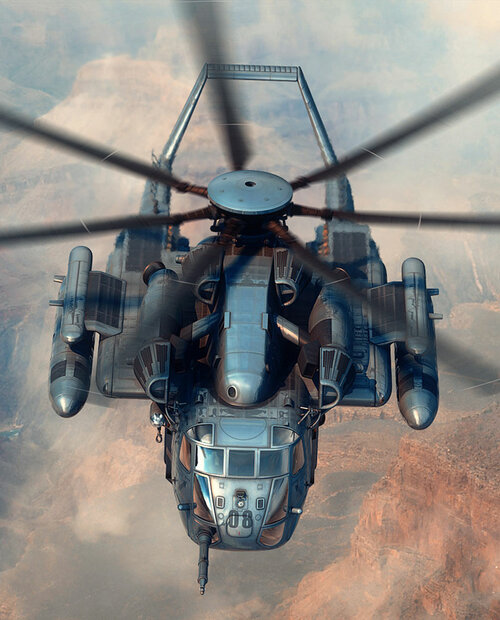Bell’s Invictus gets new tail, is 75 percent complete
BY DAN PARSONS | FEBRUARY 3, 2022
Estimated reading time 6 minutes, 10 seconds.
Bell’s 360 Invictus advanced helicopter is 75 percent complete and has had its new open tail rotor system attached at the company’s facility in Amarillo, Texas.
Originally designed with a canted, ducted tail rotor, Invictus’ entire tail boom structure was
reconfigured to simplify the design and speed building Bell’s pitch for the U.S. Army’s Future Attack Recon Aircraft.
The Bell 360 Invictus competitive prototype at the company’s manufacturing facility in Amarillo, Texas. Bell Photo
A new photo shared by Bell shows the tandem-cockpit, single-main-rotor helicopter on its build stand, its fuselage nearly complete and the tail boom attached. The company released artist renderings of the helicopter with a ducted tail and built the tail but decided when the aircraft was already half built to completely redesign the anti-torque system.
Keith Flail, Bell’s executive vice president for advanced vertical lift systems, said the redesign was a result of building a competitive prototype (CP) while at the same time refining the design of the ultimate FARA weapon system.
“One of the things we looked at is as we were doing a competitive prototype, and at the same time are iterating on a weapon system of what the [engineering and manufacturing development] aircraft is going to be — the increment one aircraft — and the way we’re organized is to maintain the connective tissue between those two so that we can keep them as close as possible in terms of what we’re doing on the CP and what the weapon system will be,” Flail recently told reporters on a media trip to Texas.
Initial concept art of the Bell 360 Invictus attack reconnaissance helicopter. Note the ducted, canted tail rotor. Bell Image
When Bell
rolled out the Invictus prototype helicopter concept in 2019, much emphasis was placed on the efficiency and added lift that would be generated by its ducted tail rotor, canted at 20 degrees to provide extra lift while hovering. Midway through building the prototype that will compete in a fly-off against Raider X, the company has redesigned everything behind the bulkhead separating the body of the aircraft from the tail boom and replaced the ducted rotor with a conventional open tail rotor system.
“Given the pace of the program, the competitive prototype, there was not the opportunity to optimize in some of the areas in terms of weight and things like that, that you would expect because you’re trying to go so fast,” Flail said. “But one of the things was that as we got to explore further the tail rotor, we started with a ducted tail rotor and as we continued to iterate and look at the holistic optimization of the aircraft, we saw from a growth potential standpoint and maximizing our hover performance and increase performance, that switching to the open tail rotor was the right answer to give that capability to the Army.”
In August, Chris Gehler, Bell’s vice president and 360 Invictus program director, explained that “the open tail provides more efficiency, and so it really came down to weight, efficiency and performance,” of the aircraft based on an Army requirement that a single General Electric T901 Improved Turbine Engine power FARA.
“We would get more performance and really, more future growth for the Army using the open tail,” Gehler said in an August interview.
Concurrent to building the actual aircraft, the Invictus’ main rotor gearbox, supplemental power unit gearbox, engine reduction gearbox driveshafts and couplings are being tested at Bell’s Drive Systems Test Lab (DSTL).
Designed to fly at least 180 knots, per Army speed requirements, Invictus borrows its main rotor system from the 525 Relentless, which has been flown at speeds above 200 knots in test flights. Both the shrouded hub and rotor blades have been “ported over” from the 525 program, but will be scaled to fit the Invictus. Where the 525 has five blades, Invictus will have four and will not exceed the Army’s 40-foot rotor disc size limitation.
Bell’s sole competition for FARA is the Sikorsky Raider X, a compound helicopter with coaxial, counter-spinning main rotors and a pusher propeller. That aircraft also is at least 70 percent complete, but Sikorsky has not published photos of its competitive prototype being built at the company’s flight test facility in West Palm Beach, Florida.
THIS IS THE NEW TAIL:










